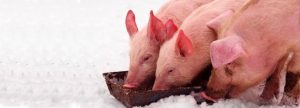 09 Feb 2023
09 Feb 2023
Rice is a grain which is mainly produced for human consumption. However, that does not mean, that it is exceptionally included in diets for domestic and meat-producing animals. Considering that the composition of such diets has concentrated sources of carbohydrates (mainly from corn) and proteins (mainly from soy). According to studies conducted by Embrapa Swine and Poultry, from a nutritional perspective, brown rice (peeled but not polished), can complement or replace corn in animal feed. There are also other alternatives to feed these monogastric species like (cassava, sweet potato, rice bran and cotton).
The high price of corn in recent years has motivated pig and poultry producers to look at rice as an alternative to corn, given the relative value of both grains. A relief for animal protein producers in Rio Grande do Sul (RS) and Santa Catarina (SC), the largest importers of corn among Brazilian states and responsible for producing 91% of the national rice crop, which leads them to face high prices of corn and soybeans brought from other States. Meanwhile rice leftovers are stored in local warehouses, which contributes to reducing its market price.
The alternative of rice in place of corn in the formulation of feed to feed meat-producing domestic animals seems to be rational as long as the price of rice is also not high, which is not the case at this time, since there is one on rice supply in the Southern Brazilian market, as a consequence of good productivity, the Covid 19 Pandemic, the Russia-Ukraine conflict, the appreciation of the dollar against the real, and the declines in the first and second corn crops in Brazil in the last three years, leaving the grain of rice cheaper, relative to corn.

According to studies by Cepea (Center for Advanced Studies in Applied Economics), the average price of corn and soybean bags increased, respectively, 93.9% and 68.1% in the last three years (2021), intuiting that the cost of producing pigs and poultry increased, respectively, in the same proportion.
The freight price also counts in the final price of the grains. So, if the lack of corn occurs in regions where rice remains, as happens in RS and SC, responsible for the largest share of the national grain production and also large producers of meat, the combination is perfect.
The feed used in animal feed is excessively concentrated in the use of corn and soybeans as raw materials for meat production. And that’s not good. It would be desirable to look for other alternatives to ensure a continuous flow of food to meet the needs of pigs and poultry.
The cultivation of wheat and triticale, for example, among other winter grains, would be an excellent strategy using idle areas after the summer harvest and which are available during the cold season.
The use of winter cereals in the feeding of pigs and poultry is already a reality in the southern region of Brazil and with the high prices of traditional raw materials used in the feeding of domestic animals (corn and soybeans, mainly), the trend signals an increasing increase in the use of this alternative.
According to epagri (Agricultural research company of the State of Santa Catarina), a program was recently launched to encourage the planting of winter grains in the state, aiming to reduce its enormous dependence on corn, the largest among Brazilian states and also, seeking to take advantage of agricultural land that is idle in the winter period.

Rio Grande do Sul has adhered to the same strategy and is encouraging a Project called Two Crops (launched in 2021), which aims to encourage the use of idle areas in winter and also sew agreements with the pig and poultry industries to ensure contracts for future purchase of cereals produced in the cold months.
Source: This article originally appeared in Nutrinews Brasil as a content in portuguese. Written by Agricultural Engineer Amélio Dall’Agnol, ao Folha de Londrina
Subscribe now to the technical magazine of animal nutrition
AUTHORS

Nutritional Interventions to Improve Fertility in Male Broiler Breeders
Edgar Oviedo
The Use of Organic Acids in Poultry: A Natural Path to Health and Productivity
M. Naeem
Synergistic Benefits of Prebiotics and Probiotics in Poultry, Swine, and Cattle
Gustavo Adolfo Quintana-Ospina
Hybrid Rye Potential in Laying Hen Feed Rations
Gwendolyn Jones
A day in the life of phosphorus in pigs: Part I
Rafael Duran Giménez-Rico
Use of enzymes in diets for ruminants
Braulio de la Calle Campos
Minerals and Hoof Health in the Pregnant Sow
Juan Gabriel Espino
Impact of Oxidized Fats on Swine Reproduction and Offspring
Maria Alejandra Perez Alvarado